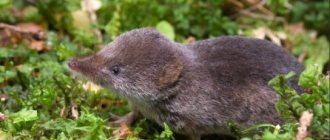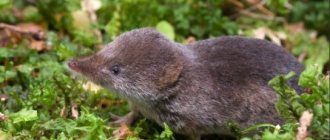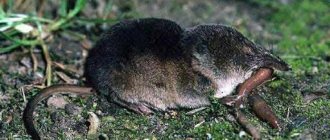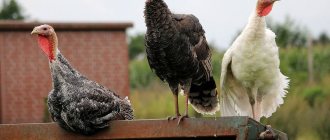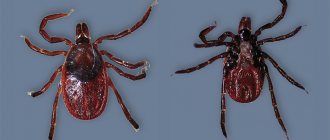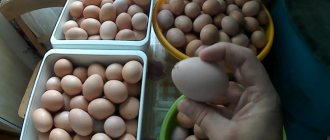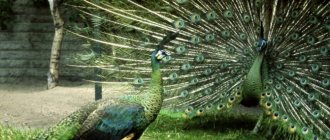- Wild animals
- >>
- Mammals
The shrew (Sorex) is a small insectivorous animal from the shrew family. They live on all continents in the northern hemisphere, mainly in forests and tundra. This genus includes the winners in the categories “smallest” and “most voracious” among mammals. They challenge Bergman's law and demonstrate the Danel effect. In total there are about 70 species in the genus, of which 15–17 species are in Russia.
Origin of the species and description
Photo: Shrew
The Latin name of the genus comes from a word meaning “whisper, chirp, buzz.” This refers to the sounds that animals make during collisions with each other. The Russian name of the genus is given for the reddish-brown color of the tops of the teeth.
The types are distinguished based on the structure of the teeth, which is quite difficult for a non-specialist. The taxonomy is poorly developed; today there are different classifications, according to one of them there are three subgroups.
Video: Shrew
But according to another - four:
- species of unknown origin, including the tiny shrew (Sorex minutissimus) - indeed, the tiniest mammal in Russia and the second in the world, smaller than only the dwarf shrew (multi-toothed shrew) from the same shrews;
- subgenus Sorex, which includes the common shrew, also known as the shrew (Sorex araneus) - the most common and typical representative of the genus and the most numerous mammal of northern Europe;
- subgenus Ognevia with the only, but largest, representative - the giant shrew (Sorex mirabilis);
- The subgenus Otisorex includes mainly North American species and the smallest native mammal, the American pygmy shrew (Sorex hoyi).
The fossils date back to the Upper Eocene, the time when modern orders of mammals appeared.
How to get rid of it: effective methods
There are many ways to control rodents in the garden. The same methods can be used to combat shrews. Since these mammals are not specifically interested in the vegetable garden or garden, they can disappear as quickly as they appear. In addition, they can return at any time. These are not mice that practically live in the garden and garden for years, because there is enough food for them here, but in the winter they begin to attack human homes. At the same time, they can eat something that can hardly be called edible. As for shrews, they lead a completely different way of life. If the mouse is a serious pest, then the shrew is most likely a garden nurse. To combat it, it is enough to use traditional methods, traps or repellers.
Chemicals
The advantage of chemical control agents is that they are effective. The principle of action of chemicals is based on poisoning animals, which leads to their death. The disadvantage of such drugs is that they are poisonous and they do not care who they poison, an animal or a person. In this regard, many owners try not to get involved with toxic substances.
As a last resort, you can use:
- Hunter Antirodent.
- The Nutcracker.
- Rat death.
Physical methods of struggle
Considering the fact that the shrew is more useful than harmful, more humane methods of control can be used in relation to it. As an option, it is permissible to install ultrasonic repellers. Such devices operate at a distance of up to 30 meters, and some models - at a distance of up to 1 km.
In addition to such devices, you can use traps that work on the principle of mousetraps. The most preferable option is live traps. Such traps are made in the form of a pipe, on both sides of which there are dampers that open only inward.
Appearance and features
Photo: What does a shrew look like?
At first glance, the animals look like mice, but they belong to a completely different order - insectivores. Upon closer examination, the body structure is noticeably different from that of a mouse. First of all, the relatively large head with a muzzle elongated into a flexible proboscis catches the eye. The animal constantly moves it, sniffing and looking for prey. The ears are tiny and practically do not protrude from the fur. The eyes are microscopic and completely expressionless.
If we consider them a mirror of the soul, then the shrew has almost no soul - all the animal’s thoughts are only about its daily bread. But such small animals cannot do otherwise, they lose too much heat compared to large ones, they constantly require energy replenishment of metabolic processes, which go on at breakneck speed. “The less weight, the more food” is a general rule for all warm-blooded animals. Babies have 32 teeth, like a human, but the incisors, especially the lower ones, are very long. Milk teeth are replaced by permanent ones even in the embryo, so that the animal is born fully equipped with all teeth.
The body length (without tail) in different species can range from 4 cm in a tiny shrew to 10 cm in a giant shrew; weight ranges from 1.2 - 4 g to 14 g, respectively. The average size, for example, of a common shrew is 6–9 cm plus a tail of 3–5.5 cm. The body is covered with velvety thick fur sticking out vertically, so the shrew cannot be stroked against the grain. The color of the fur on the upper side is reddish, brownish or grayish and camouflages the animal well on the ground; on the lower side the body is light gray.
The tail can be either very short or almost equal to the body, covered with sparse hairs. There are usually glands on the sides and base of the tail that secrete a pungently smelling musky secretion that protects the shrew from predators. Females have from 6 to 10 nipples. In males, the testes are located inside the body, and the copulatory organ can reach 2/3 of the body length.
Interesting fact: The shrew's skull is like an elongated triangle - it has a greatly expanded brain section and narrows towards the nose, so that the jaws look like tweezers. By winter, the skull decreases, reducing the volume of the brain, and in summer it increases (the so-called “Danel effect”). The brain makes up 10% of the weight of the entire animal and this ratio is greater than that of a human or even a dolphin. Apparently, the constant need to solve problems with food contributes to brain development.
Diet[edit]
Every day this shrew consumes up to three times its body weight in food. [4] It eats small quantities of underground fungi and seeds, although it is primarily carnivorous. [5] It prefers insects, earthworms, voles, snails and other shrews for most of its diet, although salamanders and mice are also eaten. [5] This shrew eats vertebrates more often than other shrews. [5] The shrew primarily forages for several hours after sunset, although it is also active on cloudy days. [5]High water loss through evaporation requires the shrew to have access to a water source, although it also obtains water from food. [3] The shrew often hoards food, especially in autumn and winter or during times of prey abundance; [3] one study found that it caches 87% of prey it catches, while 9% is eaten immediately and 4% remains where it is killed. [10]
Toxin[edit]
The saliva of the northern short-tailed shrew contains kallikrein-like protease, used to paralyze and subdue its prey. [11] The toxin is strong enough to kill small animals up to several sizes larger than the shrew itself, and causes painful bites to people who try to handle the shrew. [3] Poisonous saliva is secreted from the submandibular glands through a duct that opens at the base of the lower incisors, where the saliva flows along a groove formed by the two incisors into the victim. [3] [5] The toxin is very similar in structure to that produced by the Mexican beaded lizard ( Heloderma horridum
), which independently developed its toxin from the same precursor protein. [12]
Where does the shrew live?
Photo: Shrew in Russia
The range of the genus covers mainly the subarctic and temperate zones of all continents of the northern hemisphere. In more southern regions, such as Central America or Central Asia, shrews are found in the highlands.
A typical representative, the common shrew, is the most versatile and adapted to life in a wide variety of natural zones from the northern tundra to the lowland steppes, where it chooses floodplains and tall grass meadows for settlement. The animals do not like open places and cannot tolerate direct sunlight - their favorite habitats are always shady and damp. In winter they live under a layer of snow, practically never coming to the surface.
In central Russia, common shrews are found everywhere in forests and parks, especially cluttered ones, with dense undergrowth and a thick layer of forest litter. They live along the banks of stagnant bodies of water in thickets of coastal vegetation, near swamps. But they are also common in cultivated summer cottages, which is confirmed by cats bringing them as prey. They are especially drawn to human habitation on the eve of winter, when they can even climb into houses.
Interesting fact: The smallest species live in the tundra and highlands and endure the fierce frosts of central Siberia, although it would seem they should strive for warm places. Moreover, studies of the American ash shrew (Sorex cinereus) have shown that the body size of the animals decreases the further north they live. This contradicts Bergmann's well-known rule, according to which the size of individuals in cold areas of the range should increase.
Now you know where the shrew is found. Let's see what this animal eats.
Predation
The northern short-tailed shrew has a high mortality rate, although it attempts to avoid predation by hiding under vegetation, soil, leaf litter or snow;[4] only 6% of the observed group of shrews survived into the next year,[5] and winter mortality was 90% , likely due to cold stress.[3] This shrew is eaten by many predators: trout, snakes, raptors, canids, cats, mustelids, skunks, raccoons, and opossums,[3][5] although the mammalian carnivores seem to be deterred by the musky odor produced by the shrew's scent glands.[5]
What does a shrew eat?
Photo: Shrew from the Red Book
When searching for food, shrews are guided by a keen sense of smell and keen hearing; some species use echolocation. Animal food, as the most high-calorie food, forms the basis of the diet. The shrew eats everything it can catch and chew with its exceptionally sharp teeth - needles.
It can be:
- any insects at all stages of development, Coleoptera, Diptera and Lepidoptera, with more larvae being eaten;
- spiders;
- earthworms;
- mollusks, including slugs, to which shrews owe worms;
- other invertebrates; for example, nods, which are eaten by the giant shrew;
- baby mouse-like rodents;
- small amphibians;
- carrion, such as a bird or mouse;
- in extreme cases, he engages in cannibalism, even eating his own children;
- in winter it consumes plant foods, in particular coniferous seeds, which can make up up to half of the diet;
- also eats mushrooms and droppings.
In search of food, it makes narrow branched passages in the snow. The amount of food eaten per day is 2 to 4 times more than the weight of the animal itself.
Taxonomy
B. brevicauda
It is a red-toothed shrew, one of three or four species (depending on power)[3] in the genus
Blarina
.
Previously considered a sister subspecies of the southern short-tailed shrew ( B. carolinensis
).[3]
The species has been divided into 11 subspecies based on morphological characteristics, which are grouped into two subspecies: B. b.
Brevicauda and
B. b.
talpoids ; these groupings were reflected in molecular systematics by the study of mitochondrial cytochrome b sequence.[6] It is believed that the two groups of subspecies were isolated from each other. Pleistocene glaciers.[6]
Features of character and lifestyle
Photo: Common shrew
Our closest neighbor in the natural world is the most studied - the common shrew. Using her example, let's look at how these animals live and what they do. The shrew is agile and agile. Despite her weak legs, she cheerfully makes her way through the grass and loose forest floor, snoops under fallen bark and brushwood, can climb tree butts, swim and jump. She does not dig holes, but uses other people's underground passages, not being interested in the owner's opinion. The greedy baby is driven by the demands of the stomach and death from hunger is more real for her than from the teeth of a predator. Without food, it dies within 7 - 9 hours, and smaller species - after 5.
The animal spends more than half of its time, 66.5%, in motion and continuously searching for food. After eating, he sleeps, and after sleeping, he goes in search of food and such cycles during the day can be from 9 to 15, the slightest delay in this cycle will cost him his life. During the search, he covers up to 2.5 km per day. When food supplies are depleted, it moves to other places.
In autumn, and especially in winter, the shrew reduces activity, but does not hibernate. The baby simply cannot accumulate enough reserves for wintering and is forced to spin around even in frosty weather. It's amazing that she even survives until spring. Molting occurs in April - May and September - October, like all inhabitants of places with a seasonal climate. In winter, the skin becomes lighter. The sounds can be identified as squeaking, chirping or thin chirping. They are emitted mainly during a meeting and the fight that follows it.
Interesting fact: The tiny shrew eats 120 times every 10 to 50 minutes during the day. However, it lives in a colder zone of Eurasia than the common shrew.
Behavior
Other shrews spend more time above ground than the northern short-tailed shrew, which prefers to tunnel underground through leaf litter, or at the snow/ground interface.[3][5] Bouts of frantic activity lasting about five minutes are followed by longer periods of rest, with total activity time accounting for only 16% of a 24-hour day.[3] This animal is capable of digging at a speed of 2.5 cm/min in between rests.[3]
The shrew builds a nest up to 20 cm (8 in) in diameter underground or under a log and lines it with leaves or the fur of the meadow vole ( Microtus pennsylvanicus
).[3][5] This nest is kept clean and waste is disposed of outside the nest in the latrine.[3][5] Other parts of the burrow system are used for food storage.[5]
Usually solitary,[4] B. brevicauda
exhibits several aggressive displays and vocalizations to repel other members of the species in encounters.[16] Pairs of shrews that were caged at the same time coexisted for less than four months before one shrew killed the other, and a new shrew caged with an already established shrew would be killed within hours.[17]
Social structure and reproduction
Photo: Baby shrew
Shrews do not live together and when they meet, they show aggression, attacking each other screaming and emitting their signature smell. The male and female unite only for a short moment to mate, which in the common shrew can occur 3 or 4 times from April to October.
After the meeting, the female finds an old stump, hummock, trunk, empty hole or pile of brushwood and makes a nest from hay, moss or leaves. The nest is round with a cavity 8-10 cm in diameter. After about three weeks, the female gives birth to (3)6 – 8(11) children. The weight of the cub is about 0.5 g, length is less than 2 cm, it does not see, lacks hair and even a proboscis. But after 22–25 days, the new generation is completely ready for independent life, and the female is ready for new reproduction.
The young become sexually mature the following year, although the first spring litter is capable of breeding after three or four months. The rush is quite justified - super active animals live no more than 2 years. Which is common to all representatives of the genus.
Interesting fact: If the nest is in danger, the mother and young cubs of some species (common shrew, ashen shrew) form so-called “caravans” - the first child grabs the mother by the base of the tail, the rest similarly cling to each other. This is how they move around in search of safe shelter. There is another opinion that they are exploring the surrounding area, conducting “nature excursions,” so to speak.
Notes
- Mammals. Large encyclopedic dictionary / scientific. ed. I. Ya. Pavlinov. - M.: ACT, 1999. - P. 36. - 416 p. — ISBN 5-237-03132-3.
- Sokolov V. E.
Five-language dictionary of animal names. Mammals. Latin, Russian, English, German, French. / under the general editorship of academician. V. E. Sokolova. - M.: Rus. lang., 1984. - P. 39. - 10,000 copies. - Hutterer, Rainer
. Soricomorpha. // Wilson, Don E., and Reeder, DeeAnn M. ed. Mammal Species of the World (3rd ed.). Baltimore: Johns Hopkins University Press, 2 vols. (2142 pp.). pp. 285-286. ISBN 978-0-8018-8221-0. OCLC 62265494. - Won, Byeong-o (원병오).
한국의 포유동물 (Hangugui poyudongmul, Mammals of Korea). - Seoul: Dongbang Media, 2004. - ISBN 89-8457-310-8. - Andrew T. Smith, Yan Xie (eds.)
A Guide to the Mammals of China. Princeton. 2008. 544 p. - ↑ Hutterer, Rainer
. Soricomorpha. // Wilson, Don E., and Reeder, DeeAnn M. ed. Mammal Species of the World (3rd ed.). Baltimore: Johns Hopkins University Press, 2 vols. (2142 pp.). pp. 285-286. ISBN 978-0-8018-8221-0. OCLC 62265494. - Sokolov V. E., Orlov V. N.,
Key to mammals of the Mongolian People's Republic M.: Science. 1980. 351 p. - A. Bekenov, P. M. Butovsky, B. B. Kasabekov and others.
Mammals of Kazakhstan. T. 4. Insectivores and bats. Alma-Ata: Science. 279 p.
Natural enemies of shrews
Photo: Gray shrew
Everyone has enemies, even such angry and foul-smelling little ones. Some simply kill them, while others may even eat them if they do not have a good sense of smell.
This:
- mammalian predators, including domestic cats, which usually abandon their prey without eating it;
- owls that eat them despite the smell;
- hawks and other diurnal predators;
- storks;
- vipers and other snakes;
- predatory fish grab swimming animals;
- the shrews themselves are dangerous to each other;
- Parasites (helminths, fleas, etc.) cause a lot of harm to health.
Shrews usually coexist peacefully with people, although of course they can come under attack during terrorist attacks against mice and rats. However, people cause the greatest harm indirectly - by changing the environment through deforestation and urban development, and using pesticides.
Interesting fact: When studying one of the populations of the common shrew, 15 species of helminths belonging to round and flatworms were found in the tiny ones. One individual contained 497 different worms. Here is a typical example of harmony in nature!
Population and species status
Photo: What does a shrew look like?
Population sizes of different species vary greatly. The most numerous and common species of Eurasia, the common shrew, can have a population of 200 - 600 specimens per hectare. The more food and hidden places for shelter, the greater the population density. Similar Eurasian ranges are found in the small, tiny, even-toothed shrews and many others. Large and densely populated habitats covering tundra and forest zones are characteristic of many American species.
Some species are more local, such as the Caucasian shrew, which inhabits the forests of the Caucasus and Transcaucasia, or the Kamchatka shrew from Kamchatka and the coast of the Sea of Okhotsk. But very rare ones, few in number and found in a small area, are not so common. Different countries have their own rarities.
The regional Red Books of Russia include:
- the tiny shrew (S. minutissimus) is protected in the Moscow, Ryazan, Tver, and Kaluga regions;
- the clawed shrew (S. unguiculatus) and the slender-nosed shrew (Sorex gracillimus) are included in the Red Book of the Amur Region;
- Radde's shrew (S. raddei) in the CC of a number of North Caucasian republics;
- The small shrew (S. minutus) is a Crimean rarity. Just in case, it is also included in the Red Book of Moscow as an indicator of forests preserved in an undisturbed state. Although in general the species is not threatened;
- The equal-toothed shrew (S. isodon) is protected in the Moscow region and Karelia. The range covers the forest zone of Eurasia from Scandinavia to the Pacific Ocean.
Distribution
Fossils
Most records of B. brevicauda
from the Pleistocene,[7] although one record from the late Pliocene (Blancan age of land mammals) tentatively assigns this species.[8]
Another source indicates the earliest mention of the Blarin
is a specimen of
B. b.
thalpoids , from Blancan (early Pleistocene) to Kansas.
The species is believed to have originated in the mid to late Pliocene.[3] In B. b.
Brevicauda subspecies appeared later.[3]
Classify
This shrew is found throughout central and eastern North America, from southern Saskatchewan to Atlantic Canada and from south to north Arkansas and Georgia.[4][9] This is probably the most common shrew in the Great Lakes region.[3][5] Population densities typically range from five to 30 shrews per hectare (two to 12 per acre), but rarely exceed 200/ha (80/acre).[5] The typical range of a shrew is 2.5 ha and may overlap slightly with the range of other shrews.[3]
Habitat
Both disturbed and undisturbed habitats are used by the northern short-tailed shrew, including grasslands, old fields, fences, wetlands, deciduous and coniferous forests, and home gardens,[3][4][5] although habitats that are moist with litter are preferred from leaves or thick plant cover.[3][5] Burnt forests are not repopulated quickly. B. brevicauda
,[4] and shrews quickly clear clearcuts.[3]
